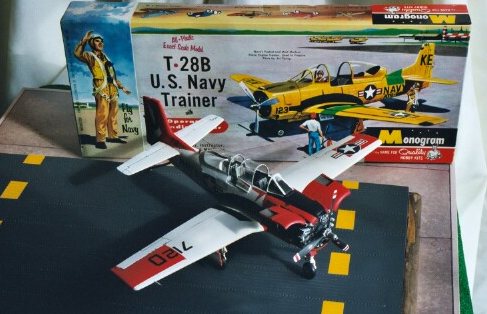
Monogram 1/48 T-28B Trojan
| KIT #: | 5100 |
| PRICE: | $3.98 MSRP back in 1975 |
| DECALS: | One option |
| REVIEWER: | Andrew Garcia |
| NOTES: | Aeromaster decals, Black Box and Aries resin used |

| HISTORY |
What aircraft can out-climb and out-turn a P-51 Mustang? The T-28 Trojan
will out-climb and out-turn the P-51 Mustang according to the “Final Tour
of Duty N.A. T-28 Trojans text. Why? It is due to their outstanding
power-to-weight ratio. The T-28 Trojan actually has superior performance
metrics than most WW II fighter aircraft. This sounds like my kind of
trainer aircraft. Like the Mustang, it also was used as a close-support
aircraft and one pilot even completed over 5,000 missions in T-28’s! As
the book by Robert Genat rightly states – “The more you’re around T-28’s
the better they get.”
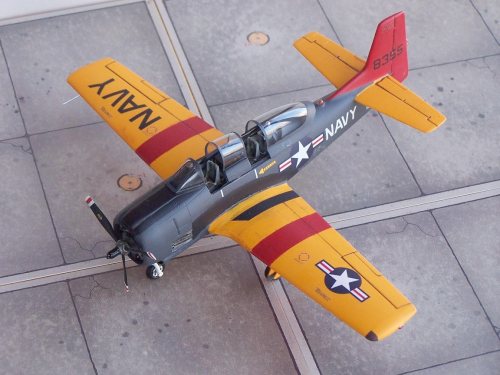 In 1948 the T-28A was chosen to replace the T-6 trainer. It was first flown
on September 24, 1949, and entered production in 1950. The U.S. Air Force
ordered 266 units of this version (T-28A). It was powered by an 800 hp.
R-1300-A Wright Cyclone engine, whereas the later U.S. Navy versions (T-28B
and -C) were powered by a R-1820-9HD Wright Cyclone 1,425 hp. engine. The
T-28B was purely a land based aircraft and the one that many student pilots
flew. To perform carrier landing and takeoffs, the T-28C, which had an
arrestor hook fitted into a cut away rear fuselage, was used. When
production ended in 1957, a total of 1,948 ( 489 “B’s”, 299 “C’s”, and over
321 “D’s) of these three versions had been built. The actual version
numbers do not add up due to some recycling of airframes. Some “A’s” were
converted to “D’s, some B’s remanufactured into “D’s”, and even some C’s”
had their hooks pulled and faired over then converted to the “D” standard
and were called AT-28D Trojan. A few Navy T-28Bs eventually went into the
Air Force inventory and a few others were turned over to the U.S. Army so
trying to be precise about modeling this aircraft can lead to some
disagreements. My take on this is use a photo reference for your own peace
of mind and don’t argue with anyone since chances are you are both right.
In 1948 the T-28A was chosen to replace the T-6 trainer. It was first flown
on September 24, 1949, and entered production in 1950. The U.S. Air Force
ordered 266 units of this version (T-28A). It was powered by an 800 hp.
R-1300-A Wright Cyclone engine, whereas the later U.S. Navy versions (T-28B
and -C) were powered by a R-1820-9HD Wright Cyclone 1,425 hp. engine. The
T-28B was purely a land based aircraft and the one that many student pilots
flew. To perform carrier landing and takeoffs, the T-28C, which had an
arrestor hook fitted into a cut away rear fuselage, was used. When
production ended in 1957, a total of 1,948 ( 489 “B’s”, 299 “C’s”, and over
321 “D’s) of these three versions had been built. The actual version
numbers do not add up due to some recycling of airframes. Some “A’s” were
converted to “D’s, some B’s remanufactured into “D’s”, and even some C’s”
had their hooks pulled and faired over then converted to the “D” standard
and were called AT-28D Trojan. A few Navy T-28Bs eventually went into the
Air Force inventory and a few others were turned over to the U.S. Army so
trying to be precise about modeling this aircraft can lead to some
disagreements. My take on this is use a photo reference for your own peace
of mind and don’t argue with anyone since chances are you are both right.
In 1962, the Air Force began a program to modify more than 200 T-28As into
T-28D "Nomad" tactical fighter-bombers for counter-insurgency warfare in
Vietnam. Equipped with the larger 1,425 hp. engines and many other changes,
the T-28Ds eventually proved to be an effective close air support weapon
against enemy ground forces. The South Vietnamese Air Force (VNAF) used a
number of USAF-supplied T-28Bs (Farm Gate detachment and modification
program) in a similar role until the T-28Ds became available.
Other users of the T-28 were France which used re-engined T-28As as the
T-28S 'Fennec' COIN aircraft in Algeria and Haiti. There were many other
users such as Argentina, Cuba, Nicaraguua, Brazil (T-28R-1), Formosa
(Taiwan), Japan, Korea, Mexico, Honduras and Morrocco. This means you have
a wide variety of colorful markings to enjoy. Unfortunately very few T-28
Trojan decal sheets in 1/48th have been released.
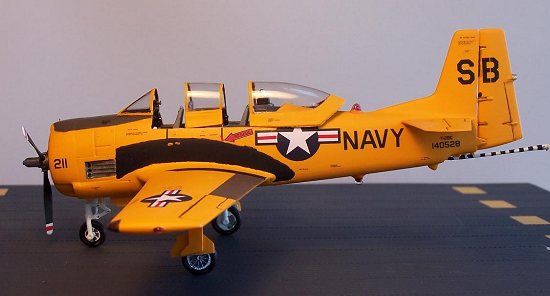 The T-28 Trojan was built in five models – the A, B, C, D and Fennec with
several variants.
The T-28 Trojan was built in five models – the A, B, C, D and Fennec with
several variants.
T-28 Versions with some Modeling Notes
T-28A Trojan - for USAF Pilot
Training ( 266 produced)
- Two-bladed Aero Products A4222-E1 10’ Propeller with a small almost flat
prop hub
- Early versions had a Roll-over pylon and High Canopy
- Later ”A” versions deleted the roll-over pylon and lowered the canopy by
4 inches
- 800HP Wright R-1300-A Engine with TWO exhaust stacks
- Oil cooler intake starts at edge of engine cowling
- Rear seat beacon light is visible (see Squadron In Action #1089 pg. 11,
12 photo)
- Carried .50 caliber mg wing pod or Mk. 51 Mod 4 Bomb Pack
- Note – the rear seat had a canvas cover for instrument flying
- Large spoked nose wheel and taxi light on landing gear strut
T-28B Trojan – for U.S. Navy Pilot Training (489 produced between 1954 –
1955) for primary, basic and instrument training.
- Three-bladed Hamilton Standard propeller of 10’ 1” (with 6 inch prop hub
dome)
- 1,425 HP Wright Cyclone R-1820-9HD Engine with THREE exhaust stacks
- Deeper more rounded cowling for larger engine
- Shortened Oil Cooler intake and bulge on left side
- Speed brake under fuselage behind landing gear area (see Squadron In
Action #1089 pg. 21)
- Smaller nose wheel (no spokes) hub (see Squadron In Action #1089 pg. 17
drawing)
- Note – rear seat had a canvas cover for instrument flying
- Occasional transparent green plastic inserted inside canopy as a
sun-shade (see Squadron In Action #1089 pg. 21 photo
- Surplus T-28B’s were turned over to the USAF and later to the VNAF in the
1960’s
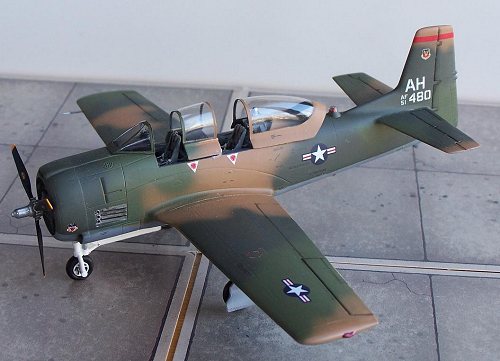 T-28BD Navy Drone Controller (6 produced)
T-28BD Navy Drone Controller (6 produced)
-T-28C – U.S. Navy Carrier Training (299 produced between 1955 – 1957) for
carrier and advanced training
- Reduced size Three-bladed Hamilton Standard propeller of 9’ 4” (with 6
inch prop hub dome)
- Tail hook added, tail skid moved forward, cut-down rudder and rear
fuselage
- If underwing gun pods or bombs are installed a pair of cowling strakes
are installed to aid in stall and spin recovery by providing front-lift to
the aircraft.
- Increased landing gear oleo travel
- 72 T-28A’s were converted tot he “C” standard configuration in N.A.
Aviation in Columbus, Ohio.
T-28D USAF Counter Insurgency
- Added Armor Plate behind the seats
- Self sealing fuel tanks
- Ejection seat on some aircraft
T-28D-5 USAF Counter Insurgency
T-28D-5 Group II USAF Counter Insurgency
T-28D-10 USAF Counter Insurgency
T-28K Brazilian modification of Fennec
T-28S Fennec French Counter Insurgency “COIN” aircraft
YAT-28E Unsuccessful Test & Evaluation Aircraft (two built)
RT-28B Photo Recon ( see Squadron In Action #1089 pg. 23 drawing and
photo)
| THE KIT |
The Monogram T-28 Trojan has a long history of kit releases. I have tried
to piece together what occurred by looking at all but the most recent
release. Scott Van Aken has provided us with some reviews of this oldie but
goodie on several occasions.
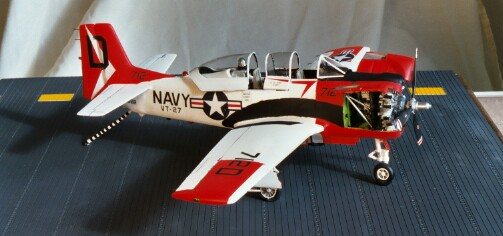 Kit PA-14 released in 1956 T-28B US Navy Trainer
Kit PA-14 released in 1956 T-28B US Navy Trainer
- This kit had and arrestor hook and operating landing gear.
Decals were for: US Navy ATU-801 KE 123 Bu No 137721
Kit PA-121 released in 1965 as a T-28D Fighter Bomber
- This kit deleted the arrestor hook and added wing gun pods, napalm pack
and 250 lb. bombs.
Decals were for:
- USAF COIN Fighter - minimal stars & bars markings Bu No 140040
- South Vietnam AF 516th FS coded LT- 21208
Kit 6805 released in 1965 through 1968 in the Blue Monogram- Mattel box
which was a reissue of the earlier Monogram PA-121 kit.
- This kit had the same contents as PA-121.
Decals are for:
- USAF COIN Fighter - minimal starts & bars markings Bu No 140040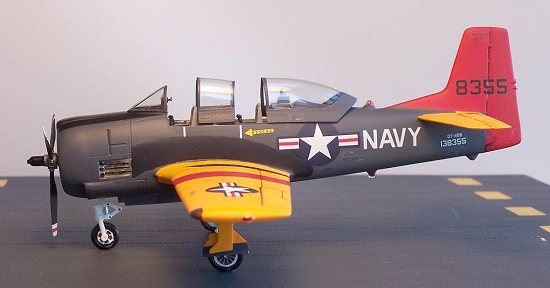
- South Vietnam AF 516th FS coded LT- 21208
Kit 5100 released in 1975 as a T-28B Trojan US Navy Training Plane
- Instructions were adapted from the earlier Monogram releases to reflect
the new aircraft markings.
- No apparent changes to the mould
Decals were for one aircraft:
- Trainer from VT-122 Tail code NJ7707 # Black 235 Bu No 137707
What I finally built used was Kit # 5100 as a basis for a T-28C Trojan
using the Black Box resin cockpit and “C” conversion parts, along with an
Aires Wright R-1820 resin engine, and Squadron resin wheels and clear vac
canopy. Just as is occurring in the computer industry, with hardware
prices falling in relation to software and other “soft” costs, this model
is a U.S. $ 1.99 cent plastic kit with $ 50.00 dollars in after market
components. I had the good fortune to buy some T-28 Trojan kits from a
Squadron bagged kit special sale several years ago for $ 1.99 cents each.
What a deal! Normally you can find the kit in the U.S. $ 5.00 to $ 10.00
dollar range at Hobby shops or swap meets.
| CONSTRUCTION |
The kit parts are acceptably detailed with subdued rivet detail and even
some recessed panel lines. I lightly sanded the rivets to reduce them and
chose not to rescribe the panel lines since photographs show a very smooth
finish with little panel or weathering. Fortunately it only had the raised
decal location lines on the props which are easily removed.
The under wing wheel wells are open featuring movable gear. I chose to box
them in along with a new nosewheel bay made from plastic card. Actually for
the wheel well I used the original kit cockpit. I cut it horizontally,
removed some plastic, glued the two pieces back together and used it as the
main landing gear well bay. If you have a Dremel drill and thin cutting
wheel it is a 5-minute task to do this and it looks pretty good. The nose
gear was done using styrene sheet. I did not use the very nice Mike West
resin parts due to the complexities caused by opening up the engine bay. I
used the kit undercarriage struts and
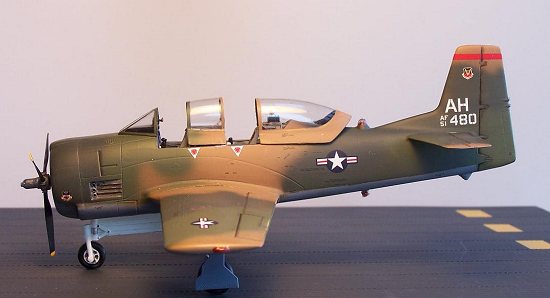 opened up the torque links and added
other details from scratch. The kit wheels were replaced with the Squadron
opened up the torque links and added
other details from scratch. The kit wheels were replaced with the Squadron
resin wheels for an F-80/T-33 since they are a similar diameter and
probably N.A. Aviation did the same. The kit undercarriage was designed to
retract so I had to carve off the over scale hinge mechanisms and fill the
resulting trenches.
The Squadron products vac canopy was
separated and combined with the Black Box components as per their
instructions.
A more recent (1999) re-release in the Monogram Classics series may still
be readily available in retail outlets. Since I had several of the earlier
releases in my personal collection I did not purchase one of these (which I
now regret!). It is my understanding that the “Monogram Classics” release
used the old T-28D components with a two-bladed Aero Products A4222-E1 10
foot prop that is correct only if used on the T-28A version. This leaves
the oil cooler opening and some other parts in need of changes. (I'm not
sure if this is correct or not.
See preview. Ed)
There are about 7 or 8 Wright R-1820 resin engines available. Verlinden
(-52) for the SBD-3, the old and OOP KMC (-56) for the General Motors FM-2,
along with a couple from Engines and Things (various dashes), one from
Teknics (for the B-17), one from Koster (?) and the newest release, the
Aires version #4166 (no dash given, but it looks close to a –40 version.).
I chose to use the Aires product.
The Aires engine scores very high in detail points with exquisite resin
casting and phenomenal etched metal parts, but when looking at reference
photos it seems the electric prop control housing is not provided and the
component found at the six o’clock location is undersized. Probably due to
Euro currency versus U.S. Dollar issues the Aires version is also a little
expensive in the U.S. The distinguishing features of different Cyclones
are found at the face of the engine crankcase, The most prominent detail
items being the type of prop governor and the ignition control box.
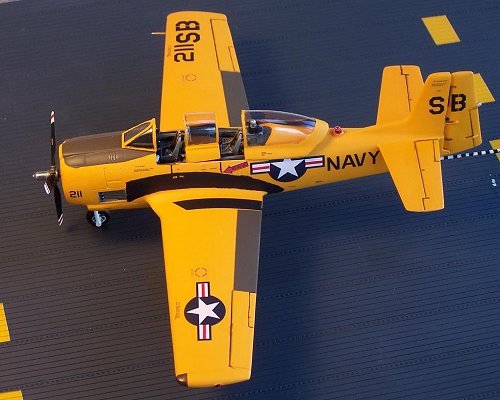 I was very surprised to find the T-28 Trojan has a pair of clamshell doors
for engine compartment access. Unlike most other aircraft that require
panels to be unscrewed and removed, the T-28’s open engine area looks like
a car hood or trunk lid opened up. This added a lot of complexity to my
open compartment exposed engine modeling. Excellent color exposed engine
detail photos were found on pages 40, 42 and 43 of the “Final Tour of
Duty North American’s T-28 Trojans” by Robert Genat text.
I was very surprised to find the T-28 Trojan has a pair of clamshell doors
for engine compartment access. Unlike most other aircraft that require
panels to be unscrewed and removed, the T-28’s open engine area looks like
a car hood or trunk lid opened up. This added a lot of complexity to my
open compartment exposed engine modeling. Excellent color exposed engine
detail photos were found on pages 40, 42 and 43 of the “Final Tour of
Duty North American’s T-28 Trojans” by Robert Genat text.
I scratch built an engine firewall, engine mounts and engine bulkhead from
styrene sheet and a portion of the ICM Spitfire firewall. Since I recently
built a Hasegawa Spitfire Mk. IX with the exposed CMK Resin Merlin engine
I doubt I will be using the ICM engine parts and they gave me a head start
on adding details.
I used the outstanding Black Box resin cockpit (# 48062). There are two BB
cockpits available, #48059 T-28D Trojan Cockpit Set Resin Cockpit detail
set, and the # 48062 USN T-28C Trojan Cockpit Set which also has the tail
hook and notched rear fuselage plug. They are flawless castings and you
will truly appreciate what they add to the kit. As with all BB cockpits
they are so well detailed they are a kit by themselves with clear
instructions. The cockpit went in without any fit problems. Excellent
color cockpit detail photos were found on pages 30,31,44,45,46,47 of the “
Final Tour of Duty North American’s T-28 Trojans” by Robert Genat.
In this build I also used the Squadron True Details TD48089 Resin Wheels
(from F-80/T-33 but they look fine on a T-28) and SQ9628 Vac-formed
Canopy for Monogram T-28 Trojan. I added some brake lines and disk brake
pads to the resin wheels for additional details.
Unless Classic Airframes or one of the Czech companies does an updated
version, this oldie is the one that you'll have to use. It has rivets,
raised panel lines and other unpleasant 1960’s kit technology standards but
it also looks very much like a T-28 when you are done. Updated with a
small amount of effort and the Black Box resin cockpit and Mike West resin
components and you have a gem in your built kit collection. You will not
regret building one! Maybe next time I build another T-28 Trojan I will add
the battery that slides out on a rail and the nearby a power receptacle
along with the fold-down ladder in the nose-wheel well.
| COLORS & MARKINGS |
I used Gunze acrylic paints and Testors Metalizer for the aluminum engine.
The markings are from the excellent Aero Master Decal # 48-614 American
Trojans In The Sky for a T-28C Trojan VT-27 Bu Nu 140062..
For all the T-28 Trojan modelers wondering what else is available (but hard
to find):
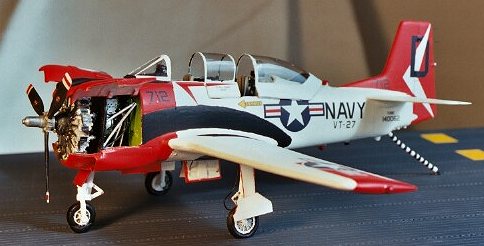 Microscale 48-109 has three aircraft on its sheet.
Microscale 48-109 has three aircraft on its sheet.
1. US Navy T-28C Bu No 140068 VT-5 Trainer Black 519 Colors: Overall
white with red orange panels and nose art (gaping mouth with teeth
and eyes).
2. USMC T-28B Bu No 138231 Quantico based Tail Code 8231 Colors:
Overall white with red orange panels
3. T-28B US Navy Bu No 137663
Microscale 48-111 has four aircraft on its sheet.
1. T-28B US Navy Bi-Centenial Markings VT-2 Bu No 138155
2. T-28D USAF 1st S.O.W. No. 55-1480
3. T-28B US Navy ATU-800 Bu No 137691
4. T-28B US Army at Edwards Air Force Base as a Helicopter Chase Plane
No. 137702
AeroMaster
AeroMaster Decals AMD 48-613 and AMD 48-614. I found Aeromaster decals
replicated several of the aircraft on the two old Microscale/Superscale
sheets, ie the US Navy T-28C Bu No 140068 VT-5 Trainer Black 519;
T-28B US Navy ATU-800 Bu No 137691 and T-28D USAF 1st S.O.W. No.
55-1480 . The AMD decals are great sheets none the less since many folks do
not have the old Microscale-Superscale releases.
AeroMaster Decal 48-613
1. Bureau number 140068, a T-28C belonging to VT-5 and wearing the 2S
tail code of NAS Saufley. The aircraft is in the Training Command high
visibility finish of overall gloss red and white with yellow cat’s eyes and
mouth on the cowling and a red and white striped rudder.
2. T-28B, Bureau number 137691 of ATU-800. The machine is finished in
another Training Command scheme of overall yellow with orange bands to the
wings and fuselage. It also sports an olive drab anti-glare panel. The
placement guide advises that the aircraft was assigned to ATU-800 whilst
the decal and the side-view show it as “ATUB00”.
3. DT-28, Bureau number 138335 of an unnamed squadron. This aircraft is
finished in the bright drone/target tug scheme of engine grey/red and
yellow.
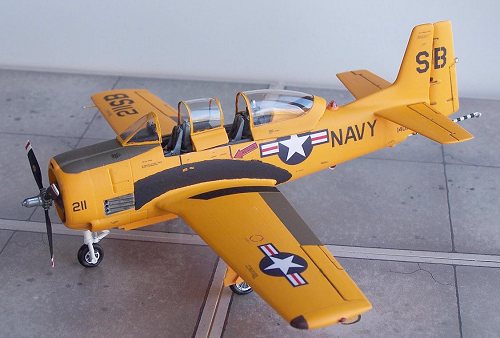 AeroMaster Decal 48-614
AeroMaster Decal 48-614
1. Bureau number 140052, a T-28C of VT27. Finish is the Training Command
high visibility scheme of overall gloss red and white with a white chevron
on the fin and rudder.
2. T-28C, Bureau number 40528 of an unnamed unit. Finish is overall gloss
yellow with an olive drab anti-glare panel and with a black SB tail code.
3. T-28D USAF # 51-480 of the Air Commandos is finished in the South East
Asia scheme of FS 34079 dark green, FS34102 mid green, FS 30219 tan (the
placement sheet lists the tan as FS32079), and FS36622 light grey. Markings
are discreet but include white tail codes/serials, Tactical Air Command
shields for the tail and unit shields (?) for the engine cowling. The
shields are provided as one-piece decals as well as two-part decals to
address any register problems that may arise. The ejection seat warning
triangles are also provided as two-part decals. A cord-wise red band for
the fin and rudder round out the markings for this machine.
4. DT-28B, Bureau number 137652. The markings depict it when it was
assigned to the U.S. Navy Test Pilot School. The machine is painted overall
white with the forward part of the fin, outer thirds of the tops and
bottoms of the wings and cowling/forward fuselage in red.
| CONCLUSIONS |
This was a great project for me. I could visualize the T-28 kit with an
Aires Resin engine and Black Box cockpit to the extent I set aside a
massive Tamiya P-47 Razorback building project (building ten simultaneously
– 3 completed) and started working on the T-28’s. The first one I built
tested my scratch building skills. The rest of the T-28’s were to satisfy
the colors and markings excitement AeroMaster generated when they released
their long awaited and superbly produced series of T-28 decals.
| REFERENCES |
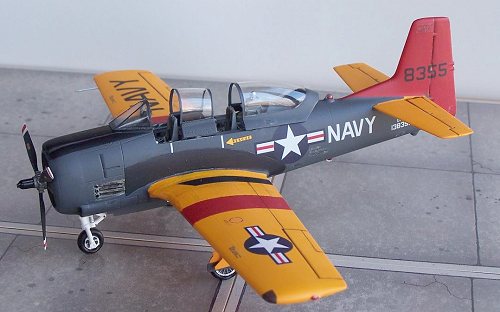 The best modeler reference is:
The best modeler reference is:
Final Tour of Duty North American’s T-28 Trojans by Robert Genat Specialty
Press 1996
It’s format features all color photography with limited text showing all
versions of the T-28. It is a combination of a “Walk-Around” book with
detailed aircraft close-up component photographs and lots of static and in
flight pictures from all angles. The best cockpit and engine detail
photographs come from this source.
The other two must have books for the
T-28 Trojan are:
North American T-28 Trojan in Navy, air Force and Foreign Service by Steve
Ginter Naval Fighters # 5
Squadron T-28 Trojan In Action # 1089
Other valuable reference sources include:
Profile # 155 The North American
T-28 Trojan by Profile Publications 1967
Air Classics August 1972 “Chitty Chitty Bang Bang” by O’Hara
Air Combat March 1981
Scale Aircraft Modeling Vol. 4 #5 February 1982
September 2004
Copyright ModelingMadness.com
If you would like your product reviewed fairly and fairly quickly, please contact the editor or see other details in the Note to Contributors.